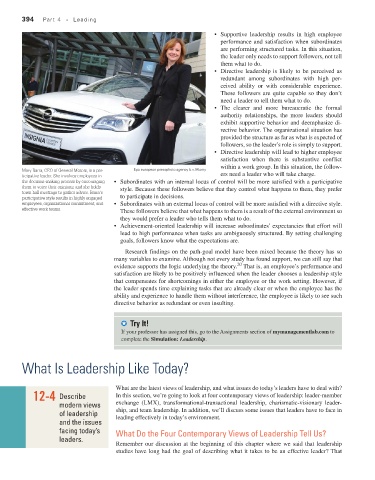Page 395 - Fundamentals of Management Myths Debunked (2017)_Flat
P. 395
394 Part 4 • Leading
• Supportive leadership results in high employee
performance and satisfaction when subordinates
are performing structured tasks. In this situation,
the leader only needs to support followers, not tell
them what to do.
• Directive leadership is likely to be perceived as
redundant among subordinates with high per-
ceived ability or with considerable experience.
These followers are quite capable so they don’t
need a leader to tell them what to do.
• The clearer and more bureaucratic the formal
authority relationships, the more leaders should
exhibit supportive behavior and deemphasize di-
rective behavior. The organizational situation has
provided the structure as far as what is expected of
followers, so the leader’s role is simply to support.
• Directive leadership will lead to higher employee
satisfaction when there is substantive conflict
within a work group. In this situation, the follow-
Mary Barra, CEO of General Motors, is a par- Epa european pressphoto agency b.v./Alamy
ticipative leader. She involves employees in ers need a leader who will take charge.
the decision-making process by encouraging • Subordinates with an internal locus of control will be more satisfied with a participative
them to voice their opinions, and she holds style. Because these followers believe that they control what happens to them, they prefer
town hall meetings to gather advice. Barra’s
participative style results in highly engaged to participate in decisions.
employees, organizational commitment, and • Subordinates with an external locus of control will be more satisfied with a directive style.
effective work teams. These followers believe that what happens to them is a result of the external environment so
they would prefer a leader who tells them what to do.
• Achievement-oriented leadership will increase subordinates’ expectancies that effort will
lead to high performance when tasks are ambiguously structured. By setting challenging
goals, followers know what the expectations are.
Research findings on the path-goal model have been mixed because the theory has so
many variables to examine. Although not every study has found support, we can still say that
20
evidence supports the logic underlying the theory. That is, an employee’s performance and
satisfaction are likely to be positively influenced when the leader chooses a leadership style
that compensates for shortcomings in either the employee or the work setting. However, if
the leader spends time explaining tasks that are already clear or when the employee has the
ability and experience to handle them without interference, the employee is likely to see such
directive behavior as redundant or even insulting.
try It!
If your professor has assigned this, go to the Assignments section of mymanagementlab.com to
complete the Simulation: Leadership.
What Is Leadership Like Today?
What are the latest views of leadership, and what issues do today’s leaders have to deal with?
12-4 Describe In this section, we’re going to look at four contemporary views of leadership: leader-member
modern views exchange (LMX), transformational-transactional leadership, charismatic-visionary leader-
of leadership ship, and team leadership. In addition, we’ll discuss some issues that leaders have to face in
leading effectively in today’s environment.
and the issues
facing today’s What Do the Four Contemporary Views of Leadership Tell Us?
leaders.
Remember our discussion at the beginning of this chapter where we said that leadership
studies have long had the goal of describing what it takes to be an effective leader? That

